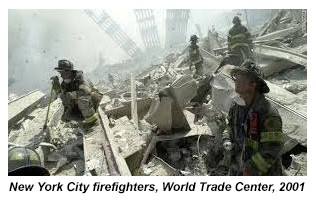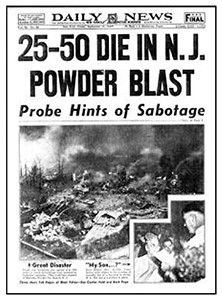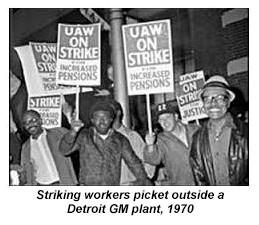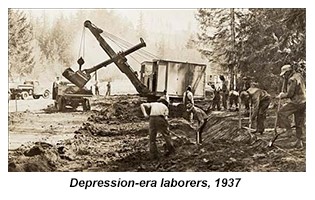This Week in Labor History
September 11
Some 75,000 coal miners in Pennsylvania, Ohio and West Virginia end a 10-week strike after winning an 8-hour day, semi-monthly pay, and the abolition of overpriced company-owned stores, where they had been forced to shop. (Remember the song, “Sixteen Tons,” by coal miner’s son Merle Travis, in which there’s this line: “I owe my soul to the company store.”) – 1897

More than 3,000 people died when suicide highjackers crashed planes into the World Trade Center towers, the Pentagon and a Pennsylvania field. Among the dead in New York were 634 union members, the majority of them New York City firefighters and police on the scene when the towers fell – 2001 Crystal Lee Sutton, the real-life Norma Rae of the movies, dies at age 68. She worked at a J.P. Stevens textile plant in Roanoke Rapids, N.C., when low pay and poor working conditions led her to become a union activist – 2009 Crystal Lee Sutton, the real-life Norma Rae of the movies, dies at age 68. She worked at a J.P. Stevens textile plant in Roanoke Rapids, N.C., when low pay and poor working conditions led her to become a union activist – 2009
September 12
Eugene V. Debs, labor leader and socialist, sentenced to 10 years for opposing World War I. While in jail Debs received one million votes for president – 1918Jobless workers march on grocery stores and seize food in Toledo, Ohio – 1932National Guardsmen fire on “sullen and rebellious” strikers at the Woonsocket (Rhode Island) Rayon plant, killing one and injuring three others. A correspondent said the crowd of about 2,000 “went completely wild with rage.” Word spread, 6,000 more workers arrived at the scene and the city was put under military rule. The governor declared that “there is a Communist uprising and not a textile strike” in the state – 1934
United Rubber Workers formed in Akron, Ohio – 1935
 A total of 49 people are killed, 200 injured, in explosion at the Hercules Powder Company plant in Kenvil, N.J. – 1940 A total of 49 people are killed, 200 injured, in explosion at the Hercules Powder Company plant in Kenvil, N.J. – 1940
New York City’s Union Square, the site of the first Labor Day in 1882, is officially named a national historic landmark. The square has long been a focal point for working class protest and political expression – 1998
September 13
 The Post Office Department orders 25,000 railway mail clerks to shoot to kill any bandits attempting to rob the mail – 1926 The Post Office Department orders 25,000 railway mail clerks to shoot to kill any bandits attempting to rob the mail – 1926
Eleven AFSCME-represented prison employees, 33 inmates die in four days of rioting at New York State’s Attica Prison and the retaking of the prison. The riot caused the nation to take a closer look at prison conditions, for inmates and their guards alike – 1971
September 14
The Amalgamated Association of Iron, Steel, and Tin Workers union calls off an unsuccessful 3-month strike against U. S. Steel Corporation subsidiaries – 1901
 Gastonia, N.C., textile mill striker and songwriter Ella May Wiggins, 29, a mother of five, is killed when local vigilantes and thugs force the pickup truck in which she is riding off the road and begin shooting – 1929 Gastonia, N.C., textile mill striker and songwriter Ella May Wiggins, 29, a mother of five, is killed when local vigilantes and thugs force the pickup truck in which she is riding off the road and begin shooting – 1929
A striker is shot by a bog owner (and town-elected official) during a walkout by some 1,500 cranberry pickers, members of the newly-formed Cape Cod Cranberry Pickers Union Local 1. State police were called, more strikers were shot and 64 were arrested. The strike was lost – 1933
Congress passes the Landrum-Griffin Act. The law expands many of the anti-labor provisions of the Taft-Hartley Act, increasing union reporting requirements and restricting secondary boycotting and picketing – 1959
 (The Essential Guide To Federal Employment Laws, 4th edition: This is a well-indexed book, updated in 2013, offering the full text of 20 federal laws affecting workers’ lives, along with plain-English explanations of each. An entire chapter is devoted to each law, explaining what is allowed and prohibited and what businesses must comply with.) (The Essential Guide To Federal Employment Laws, 4th edition: This is a well-indexed book, updated in 2013, offering the full text of 20 federal laws affecting workers’ lives, along with plain-English explanations of each. An entire chapter is devoted to each law, explaining what is allowed and prohibited and what businesses must comply with.)
September 15
Some 5,000 female cotton workers in and around Pittsburgh, Pa., strike for a 10-hour day. The next day, male trade unionists become the first male auxiliary when they gather to protect the women from police attacks. The strike ultimately failed – 1845
President Kennedy signs off on a $900 million public-works bill for projects in economically depressed areas – 1962
 More than 350,000 members of the United Auto Workers begin what is to become a 69-day strike against General Motors – 1970 More than 350,000 members of the United Auto Workers begin what is to become a 69-day strike against General Motors – 1970
Int’l Association of Siderographers merges with Int’l Association of Machinists & Aerospace Workers – 1992
September 16
More than 43,000 oil workers strike in 20 states, part of the post-war strike wave – 1945
A player lockout by the National Hockey League begins, leading to cancellation of what would have been the league’s 88th season. The lockout, over owner demands that salaries be capped, lasted 310 days – 2004
The Farm Labor Organizing Committee wins a signed contract with the Mount Olive Pickle Co. and growers, ending a 5-year boycott. The agreement marked the first time an American labor union represented guest workers – 2004
 Richard Trumka is elected president of the AFL-CIO at the federation’s convention in Pittsburgh. He had served as the secretary-treasurer under predecessor John Sweeney from 1995 to 2009, and prior to that was president of the United Mine Workers for 13 years – 2009 Richard Trumka is elected president of the AFL-CIO at the federation’s convention in Pittsburgh. He had served as the secretary-treasurer under predecessor John Sweeney from 1995 to 2009, and prior to that was president of the United Mine Workers for 13 years – 2009
September 17
Seventy-five workers die in explosion at Allegheny Arsenal, Pittsburgh, Pa. – 1862
 At a New York convention of the National Labor Congress, Susan B. Anthony calls for the formation of a Working Women’s Association. As a delegate to the Congress, she persuaded the committee on female labor to call for votes for women and equal pay for equal work. But male delegates deleted the reference to the vote – 1868 At a New York convention of the National Labor Congress, Susan B. Anthony calls for the formation of a Working Women’s Association. As a delegate to the Congress, she persuaded the committee on female labor to call for votes for women and equal pay for equal work. But male delegates deleted the reference to the vote – 1868
One hundred thousand Pennsylvania anthracite coal miners go on strike. Their average annual wage is $250. They are paid by the ton, defined by Pennsylvania as 2,400 pounds, but which mine operators have increased to as much as 4,000 pounds – 1900
National Federation of Federal Employees (NFFE) formed at a convention in Washington, D.C. In 1999 it became part of the Int’l Association of Machinists (IAM) – 1917
 Some Depression-era weekly paychecks around the New York area: physician, $55.32; engineer, $40.68; clerk, $22.15; salesman, $25.02; laborer, $20; typist, $15.09 – 1933 Some Depression-era weekly paychecks around the New York area: physician, $55.32; engineer, $40.68; clerk, $22.15; salesman, $25.02; laborer, $20; typist, $15.09 – 1933
Southern employers meeting in Greenville, N.C., ready their big counter-offensive to break the textile labor strikes that have hit the Eastern seaboard. Ultimately they deploy 10,000 national guardsmen and 15,000 deputies, but fail to drive hundreds of thousands of strikers back to work – 1934
A Southern Pacific train loaded with sugar beets strikes a makeshift bus filled with 60 migrant workers near Salinas, Calif., killing 32. The driver said the bus was so crowded he couldn’t see the train coming – 1963
A total of 98 United Mine Workers of America members and a minister occupy the Pittston Coal Company’s Moss 3 preparation plant in Carbon, Va., beginning a year-long strike. Among other issues: management demands for drastic limitations in health and pension benefits for retired and disabled miners and their dependents and beneficiaries – 1989
 The Occupy Wall Street movement is launched with an anti-Wall Street march and demonstration that ended up as a 2-month encampment in Manhattan’s Zuccotti Park. The event led to protests and movements around the world, with their focus on economic inequality, corruption, greed and the influence on government of monied interests. Their slogan: “We are the 99%.” – 2011 The Occupy Wall Street movement is launched with an anti-Wall Street march and demonstration that ended up as a 2-month encampment in Manhattan’s Zuccotti Park. The event led to protests and movements around the world, with their focus on economic inequality, corruption, greed and the influence on government of monied interests. Their slogan: “We are the 99%.” – 2011
—Compiled and edited by David Prosten |